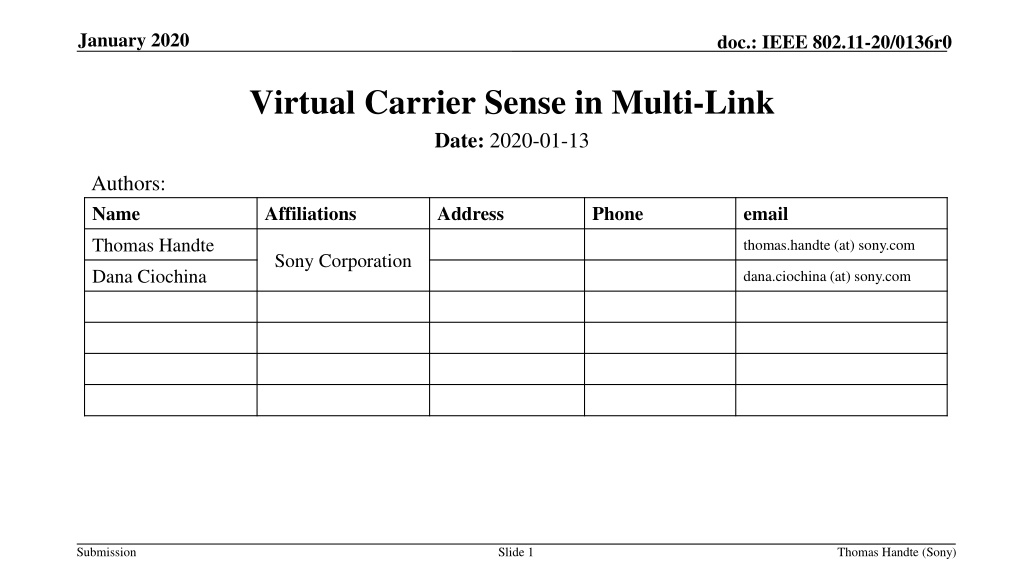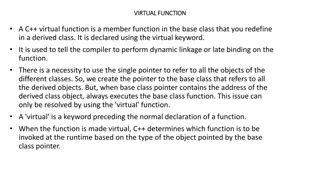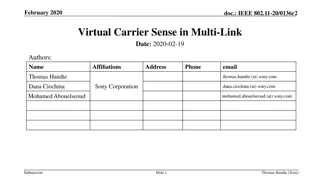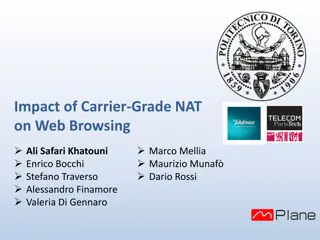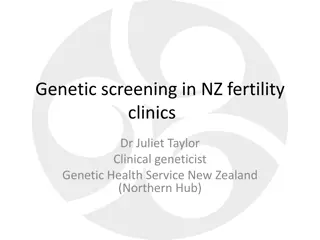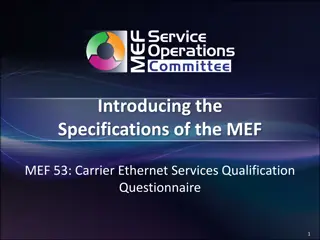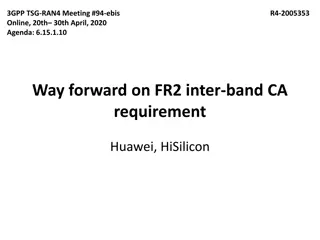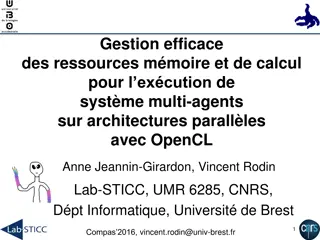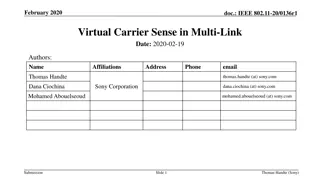Virtual Carrier Sense in Multi-Link Networks
This document discusses the implementation and advantages of virtual carrier sense in multi-link networks under the IEEE 802.11 standard. It explores the operation of multi-link setups, asynchronous communication benefits, and the necessity of multiple contention channels. The concept of NAV (Network Allocation Vector) specific to asynchronous multi-link configurations is highlighted, emphasizing the mitigation of hidden node issues and enabling efficient link switching. Additionally, the implications of having multiple primary channels in multi-link scenarios are examined, addressing concerns related to power efficiency and the need for improved STA (Station) coordination.
Download Presentation

Please find below an Image/Link to download the presentation.
The content on the website is provided AS IS for your information and personal use only. It may not be sold, licensed, or shared on other websites without obtaining consent from the author. Download presentation by click this link. If you encounter any issues during the download, it is possible that the publisher has removed the file from their server.
E N D
Presentation Transcript
January 2020 doc.: IEEE 802.11-20/0136r0 Virtual Carrier Sense in Multi-Link Date: 2020-01-13 Authors: Name Affiliations Address Phone email Thomas Handte Dana Ciochina thomas.handte (at) sony.com Sony Corporation dana.ciochina (at) sony.com Submission Slide 1 Thomas Handte (Sony)
January 2020 doc.: IEEE 802.11-20/0136r0 Introduction Multi-link is key feature of EHT Allows exchange of frames over multiple links concurrently or non-concurrently Multi-link enhances throughput and/or latency Several submissions analyzed operation of multi-link [1, 2, 3] Asynchronous or quasi-/semi-asynchronous operation provides higher gains than synchronous Asynchronous operation requires multiple contention channels [4] Contention is performed independently on each link This presentation addresses virtual carrier sense (CS) in context of multiple links How to determine NAV in asynchronous multi-link Throughout this presentation, we assume that multiple links are formed by different channels Submission Slide 2 Thomas Handte (Sony)
January 2020 doc.: IEEE 802.11-20/0136r0 Advantages of NAV specific to asynchronous multi-link Avoid hidden node problem As in single link Advantages of multi-link arise because of fast link switching Waiting for a NAV setting frame in the recently switched link is often not acceptable Multi-link NAV helps to switch from asynchronous to synchronous or quasi synchronous operation NAVs getting zero at same time is a necessary condition for successful synchronous operation Submission Slide 3 Thomas Handte (Sony)
January 2020 doc.: IEEE 802.11-20/0136r0 Primary channel in single link and multi-link Single link (today s operation) Primary/ secondary channel concept Full backoff on primary channel, PIFS backoff on secondary channels A STA maintains NAV based on observation of primary channel Multi-link Assume straight forward application of single link concept to multi-link Each link has its own primary channel i.e. multi-link has multiple primary channels Each STA needs to observe the primary channel of each link to maintain NAV information for that particular link Submission Slide 4 Thomas Handte (Sony)
January 2020 doc.: IEEE 802.11-20/0136r0 Virtual CS implications of multiple primary channels Drawbacks Power efficiency STA needs to listen to multiple primary channels (i.e. listen to each primary channel of each link) A STA may even maintain two NAVs for each link (e.g. basic and intra-BSS NAV) Restrictions on simultaneous transmit or receive operation may disallow to observe multiple primary channels at all times [3] E.g. STA is transmitting on 1st link but needs to listen on primary channel of 2nd link at same time Single radio STAs, i.e. STAs that can listen to only one link at a time, can t do simultaneous reception on multiple primary channels Slide 5 Submission Thomas Handte (Sony)
January 2020 doc.: IEEE 802.11-20/0136r0 Proposal Sharing of NAV information On each primary channel the NAV information of the other primary channel(s) of other link(s) is shared Note: The definition of a multi link primary channel where NAV information of all links is shared may be envisioned as well [5] NAV sharing should preferably be done by AP MLLE AP has likely best multi-link hardware capabilities in BSS It may access all channels of multi-link setup It may have least restrictions regarding simultaneous transmit or receive operation AP has reliable NAV information of all links at all times Example for sharing NAV(link1) over link2 Submission Slide 6 Thomas Handte (Sony)
January 2020 doc.: IEEE 802.11-20/0136r0 Proposal Envisioned AP operation Once AP obtains NAV information of a link, it shares on the other link(s) as soon as possible AP could enforce restrictions on max. PPDU or TXOP length to limit sharing delay AP doesn t share if sharing delay exceeds NAV time that is to be shared Implementation of NAV sharing Frame of CTS-type ( multi-link CTS ) Pros: simple, well-known Cons: rare update if long TXOPs present, detection MCS depended Include multi-link NAV information in 11be PHY preamble (preferred) Pros: update every time an AP transmits 11be preamble, detection MCS independent Cons: need to compress NAV info, need BSS identifier in PHY preamble (could reuse BSS Color) Submission Slide 7 Thomas Handte (Sony)
January 2020 doc.: IEEE 802.11-20/0136r0 Proposal Envisioned STA operation STA listens on the primary channel of a link or on the multi-link primary channel STA obtains NAV for this link as usual STA obtains NAV for all other links based on shared NAV Once shared NAV of a link reaches zero, a STA shall either switch to that link and determine NAV as usual or stay on the current link and await new shared NAV information If STA decides to transmit on a link that doesn t include the currently observed primary channel, it should switch to that channel before shared NAV of that link reaches zero Submission Slide 8 Thomas Handte (Sony)
January 2020 doc.: IEEE 802.11-20/0136r0 Benefits Proposal avoids reception on multiple links at same time for NAV maintenance Power efficiency No impact of joint transmission and reception restrictions Single radio STAs may participate in and benefit from multi-link operation Robust NAV detection in frames that are transmitted in non-duplicate format AP can demodulate any PPDU format If AP has restrictions for responding independently on different links [6,7], it may implement restrictions via shared NAV AP may alter shared NAV such that restrictions are fulfilled Submission Slide 9 Thomas Handte (Sony)
January 2020 doc.: IEEE 802.11-20/0136r0 Summary Virtual carrier sense is important in multi-link Maintaining NAV from multiple primary channels of multiple links has drawbacks Low power efficiency Restrictions on simultaneous transmit or receive operation may disallow for some STAs Proposal: Share NAV information among links On each primary channel of a link the NAV information of the other primary channel(s) of other link(s) is shared Sharing can be implemented via NAV information within PHY preamble Main benefits High power efficiency, no restrictions on simultaneous transmit/ receive operation Submission Slide 10 Thomas Handte (Sony)
January 2020 doc.: IEEE 802.11-20/0136r0 References [1] 11-19/1291r3 Performance aspects of Multi-link operations [2] 11-19/1405r7 Multi-Link Operation Channel Access Discussion [3] 11-19/1541r1 Performance aspects of Multi-link operations with constraints [4] 11-19/1144r6 Channel Access for Multi-link Operation [5] 11-19/1526r1 Multi-Link Power-save [6] 11-19/1836r1 Multi-link Channel Access Discussion Follow-up [7] 11-19/1548r1 Channel access design for synchronized multi-links Submission Slide 11 Thomas Handte (Sony)
